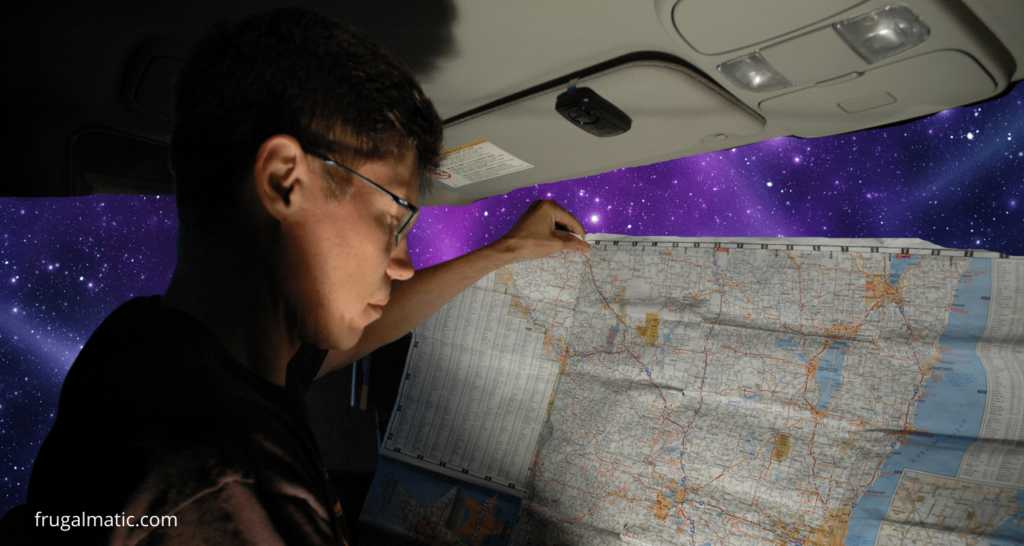This post was last updated on January 7th, 2024 at 01:21 pm
Many people who would like to give up their smartphone say they can’t because they depend on their phone’s GPS navigation system. As someone who’s never had a smartphone, I want you to know it is possible, even enjoyable, to travel without GPS. You just need to be willing to do three things: plan ahead, acquire some folded paper maps, and, most importantly, adjust your expectations.
Yes, using paper maps can feel inconvenient. But I argue these maps actually save time if giving up your smartphone means you’re wasting less time scrolling through social feeds, visiting news websites, continuous texting, or playing games. When switching from GPS to “analog” navigation, the difficult part isn’t so much the inconvenience but the challenge in managing expectations.
Unless you’re lucky enough to have an internal compass, you need to give yourself plenty of room for error when traveling without GPS, whether wrong turns or missed turns, or confusing north for south and east for west. If you treat getting from point A to point B like a nuisance standing in your way, you’re likely to become frustrated. This is one of those attitude-is-everything type situations, and you’ll stay calmer by making the process of getting from point A to point B part of the adventure.
On the way to a parade without GPS
That adventure begins with planning. As an example, I’ll use our recent trip to Milwaukee, Wis., to watch a parade celebrating the Milwaukee Bucks’ first world championship in 50 years. The long drought made Bucks fans hungry for victory, so much so that I woke up our two kids at 11 p.m. to watch the final moments of the final game against the Phoenix Suns. I didn’t want them to miss out on this historic triumph.
Soon after the Bucks announced their parade plans, I began creating my Plan A. I studied Google Maps and printed out directions to Milwaukee. But I also knew a Plan B might be necessary because the parade would require closing multiple streets. So long as I had my Rand McNally map of the city of Milwaukee, I felt confident. It didn’t matter whether streets closed, I told myself, because I could pull over and find a new path.


Our two kids and I set out for Milwaukee with the intention of arriving about 2 hours before the parade started. I lowered everyone’s expectations beforehand, preparing my kids for potential problems. “Now when we go into Milwaukee, it could be difficult to get around. Don’t expect me to easily find a spot to park,” I said. “You’re going to have to be patient.”
As it turned out, traffic was relatively light, and parking was surprisingly plentiful. Arriving early paid off, though the next challenge would be waiting for the parade to begin. About two dozen games of “I spy” later, we spotted a group of buses approaching. Finally, the parade was coming, and we were lucky to watch Giannis Antetokounmpo holding up the championship trophy as a mob of spectators followed him and his teammates along the parade route.
Have a Plan B when you travel without GPS
Not all of our travels go this smoothly. Case in point: our recent trip to Old World Wisconsin. Old World Wisconsin celebrates the state’s pioneer roots, featuring displays of old homesteads, shops, furniture, tools and various knick-knacks from long ago. It’s a history lesson and perfectly complemented a school report about Wisconsin that our daughter had written. I did the usual planning the night before our trip. I was armed with paper maps and figured this trip would be a relative breeze considering how well the Bucks parade went.
But never assume anything when traveling without GPS (or even with it), especially on lightly traveled rural roads. An unforeseen road closure forced me to take an entirely different route than the one I had planned. We arrived about 20 minutes later than anticipated, in part because I spent 5 minutes or so studying a folded paper map while parked near a “Road Closed” sign. It was time for a Plan B.
But besides muttering under my breath, I stayed calm because this is all part of the deal when you travel without GPS. You have to expect hiccups and learn to accept them rather than fight them. (At least that’s how I feel in retrospect.)


When expectations and reality collide
Many people fail in their attempts to ditch their smartphones because they don’t adjust their expectations. I’ve read and watched several online accounts from people who became quickly frustrated when trying to switch to a dumb phone, sometimes known as a flip phone or brick phone. They’re not ready to relinquish the conveniences afforded by the smartphone, even while admitting their smartphone use has become problematic.
A great example of someone trying to wrestle with this conflict between convenience and its side effects is Matt D’Avella, who offers online courses in “self-development, filmmaking, and creativity.” In December, he documented for his 3.22 million YouTube subscribers his 30-day experiment using only a flip phone. He’s a self-described minimalist, though acknowledged being smartphone dependent. D’Avella concluded at the end of the experiment, “I couldn’t imagine not going back to a smartphone because of the convenience.”
Yet at the same time, D’Avella explained that he finished “this 30-day experiment feeling more focused than I have in a while, feeling refreshed. And I feel like it’s taught me a lot about myself.” Indeed, D’Avella’s motivation for the experiment was his unhealthy habit of constantly checking the latest news developments in the 2020 presidential election. “It consumed me in a really unhealthy way,” he said. “I noticed my mental health began to deteriorate because of it.”
Don’t ask a dumb phone to do a smartphone’s job
There’s no practical way to recreate the conveniences of a smartphone with a flip phone, which I think is one reason D’Avella ultimately returned to his smartphone. He made the mistake of trying to get his dumb phone to do a smartphone’s job, namely access the internet. If you want to use your phone to access the internet, stay with a smartphone. Dumb phones are called “dumb phones” for a reason. The only thing a flip phone is good for, in my opinion, is calling and sending the occasional brief text. To try to do more than that on a flip phone is begging for disappointment, which explains why 85% of U.S. adults have smartphones.
Again, this is all about expectations. Despite his good intentions, it becomes clear that D’Avella is unwilling to accept the dumb phone on the dumb phone’s terms.
The breaking point seems to be his trip to an electronics recycler to drop off some old hard drives. Before he leaves, he spends 15 minutes trying to get Google Maps running on his flip phone. I could have told him not to bother (I have the same Alcatel phone that D’Avella used in his experiment). D’Avella did print out directions beforehand, but he didn’t appear to have any paper maps to guide him. The problem with relying only on printed-out directions is they don’t typically label streets other than the ones along the planned route. But if you miss a turn or exit, those printed directions won’t show you the way back. You’ll want a map to get back on track, or find an alternative route to your destination.
It’s no surprise to learn D’Avella felt frustrated. “If I had to do this five days a week, there’s absolutely no way I could do it,” he said about travel without GPS. “I don’t think having a flip phone full time, at least with my life, would work out. Works for my dad. Might not work for me.”
Navigating without GPS likely “works” for D’Avella’s dad because he is his own navigation system. When you travel without GPS, your brain must figure out which direction to go. GPS allows people to forget how to get somewhere, which is why I’ve noticed even some gas station attendants struggle to explain directions. Gas station attendants used to be direction experts! You’d go to a gas station if you were lost. Nowadays, many attendants couldn’t tell you how to get across town because their brains no longer house a mental map. They’ve given that job to GPS.
However, I think anyone can improve their navigational skills with practice. With a few paper maps stashed in his glove box, D’Avella would have been able to learn how to navigate without GPS. He just needed to give his experiment more time, probably six months. It might take longer than 30 days to transition away from GPS dependence.
Sometimes the ‘amazing’ can be scary
In the grand scheme, the inconvenience of traveling without GPS seems trivial next to the benefits that D’Avella acknowledged experiencing by switching to a dumb phone. Only one week into his experiment, he said, “I can already tell one of the biggest benefits is that I’m spending way less time on screens, really the moments in between. The moments when I’m making a cup of coffee, and I’m waiting for the coffee to brew. Or, when I wake up in the morning, and I’m brushing my teeth, going to the bathroom, I’m not on my phone in every single waking minute of my day. Which is amazing.”
Let’s emphasize those last words: Which is amazing.
Why not continue to embrace “amazing”? That “amazing” feeling D’Avella describes is actually freedom. And it’s puzzling to me why so many people don’t want it, but we must remember that freedom can be a little scary. When you give up a smartphone, you’re no longer tied to a screen. It sounds great, but I suspect many people, at the end of the day, feel content in their digital bubble.
Giving up a smartphone can be complicated
The truth is, there are many reasons why people feel like they can’t give up their smartphone, and GPS navigation is only one factor. If you’re interested in learning more about all the benefits and challenges related to giving up your smartphone, make sure to read my previous post on this topic. I’ll be honest, there are a lot of poor quality dumb phones being sold today. However, if you do your research, you can find some good alternatives.
I occasionally write about digital minimalism for Frugalmatic because practicing digital minimalism is one of the easiest ways to waste less time and to live a more active lifestyle. Become a subscriber to learn about the frugalmatic lifestyle. I’ll send you my Frugalmatic Starter Kit to send you on your way you to living a more physically active life. You’ll also cut back on your screen time and save some money in the process.


Hi,
Can you please recommend what type or brand of paper maps you use? Thank you!
Hi Amy,
Good question. I didn’t recommend a brand because I have several different brands (Rand McNally probably the most common) of paper maps. The thing about streets is their names and placement don’t change much over 10 or 20 years. You can find older maps that are still pretty accurate. For my state map (Wisconsin), I pick up those at Interstate rest areas. Also, if you’re looking for a map of your home city, check with your local visitor’s bureau or City Hall. I have a couple maps of my city that I got from City Hall for $5. You might also check out eBay. It’s a bit of a treasure hunt to find paper maps. But the good news is they’re not hot commodities, so you should be able to find some for a reasonable price.
Also, to keep your maps in good shape, I recommend putting packaging tape over the map creases. The creases will rip first, and the packaging tape will greatly increase the life of your map.